Table of Contents
ToggleCultural Experiances in the UAE Heritage Sites
Do you want to explore the fascinating culture of the United Arab Emirates (UAE)? From the ancient Al Ain oases to the lively heritage villages, the UAE takes you on a unique journey. It mixes the past with the present in a magical way. You’ll love the UAE’s culture, where Islamic and Arab values are at its heart.
Look beyond the tall buildings and modern sights. The UAE deeply values its cultural roots, keeping the Emirati spirit strong. The country’s warmth, love for its land, and deep traditions show the strength and joy of the people.
Key Takeaways
- Discover the UNESCO World Heritage Site of Al Ain, a city with ancient oases and archaeological wonders.
- Explore Sharjah, the “Cultural Capital of the Arab World,” and its vibrant heritage and Islamic culture.
- Immerse yourself in the UAE’s efforts to preserve its cultural traditions through festivals, events, and heritage clubs.
- Experience the rich tapestry of Emirati culture, from traditional architecture and cuisine to sports and literature.
- Uncover the UAE’s diverse heritage sites, including historic forts, mosques, and museums that offer a glimpse into the past.
Introduction to UAE's Rich Cultural Heritage
The United Arab Emirates (UAE) has a rich cultural history. It combines influences from Arabia, Islam, and Persia. It also shows a bit of East Africa and the Indian Subcontinent. These diverse cultures have deeply influenced the UAE’s architecture, music, clothing, food, and way of life.
The UAE is moving forward fast, but it stays close to its cultural roots. The country is a home to people from over 200 different countries. This makes the UAE a place where many traditions live side by side peacefully. This cultural mix shows the UAE’s strong dedication to its uae culture and heritage, emirati culture and traditions, and cultural identity.
In the UAE, you can visit over 3,000 historical sites. These places reflect the many cultures and traditions that have influenced the country. Islamic culture is key, with more than 9,000 mosques across the UAE. They are not just places to pray but also where communities come together.
Every year, the UAE also hosts many cultural events and festivals. These attract millions of people. For example, the Dubai Shopping Festival brings in over 4 million people. It’s a chance for people to celebrate and enjoy the country’s culture.
The UAE takes huge steps to keep its heritage alive. For example, the Louvre Abu Dhabi houses more than 600 artworks. It shows the UAE’s connections to global culture. There are also heritage villages where visitors can learn and experience traditional crafts, music, and customs.
“The UAE’s cultural heritage is a tapestry woven with the threads of diverse influences, creating a unique and vibrant identity that embraces both tradition and modernity.”
As the UAE grows, it makes sure to remember its roots. It values its emirati culture and traditions. The UAE works hard to keep its cultural identity of uae alive for the future.
UNESCO World Heritage Site: Al Ain Oasis
Al Ain is an ancient city in the emirate of Abu Dhabi. It’s a gem in the United Arab Emirates. This city is not just any city; it’s a UNESCO World Heritage Site. Al Ain’s rich culture has been kept safe for centuries. The key to this culture is the Al Ain Oasis, a huge natural area that amazes anyone who visits.
Exploring the Ancient Oases and Archaeological Sites
The Al Ain Oasis covers almost 3,000 acres. It has over 147,000 date palms, which is more than 100 types. This area is green and alive thanks to the smart work of the Emirati people. They’ve taken care of this oasis for thousands of years. People who visit can see the old ways of this land by looking at the ancient oases and old sites.
A special place to visit is the Bida bint Saud. It’s a prehistoric cemetery from the Neolithic era. Here, you can see round stone tombs that tell a story of the area’s first residents. Then there are the Hafeet and Hili sites. They show how smart the Iron Age people were. You can see their systems for water and their well-kept buildings.
| Landmark | Highlights |
|---|---|
| Al Ain Oasis | Sprawling over nearly 3,000 acres, with over 147,000 date palms of up to 100 different varieties |
| Bida bint Saud | Prehistoric cemetery dating back to the Neolithic era, featuring circular stone tombs |
| Hafeet and Hili | Archaeological sites showcasing the sophistication of Iron Age civilizations, with intricate aflaj irrigation systems and well-preserved structures |
The Al Ain Oasis and the places around it show a lot about the area’s cultural sites of al ain and the long-lasting al ain unesco site. Those who come to the al ain oasis world heritage site get to know the Emirati people’s old ways and the area’s ancient history.
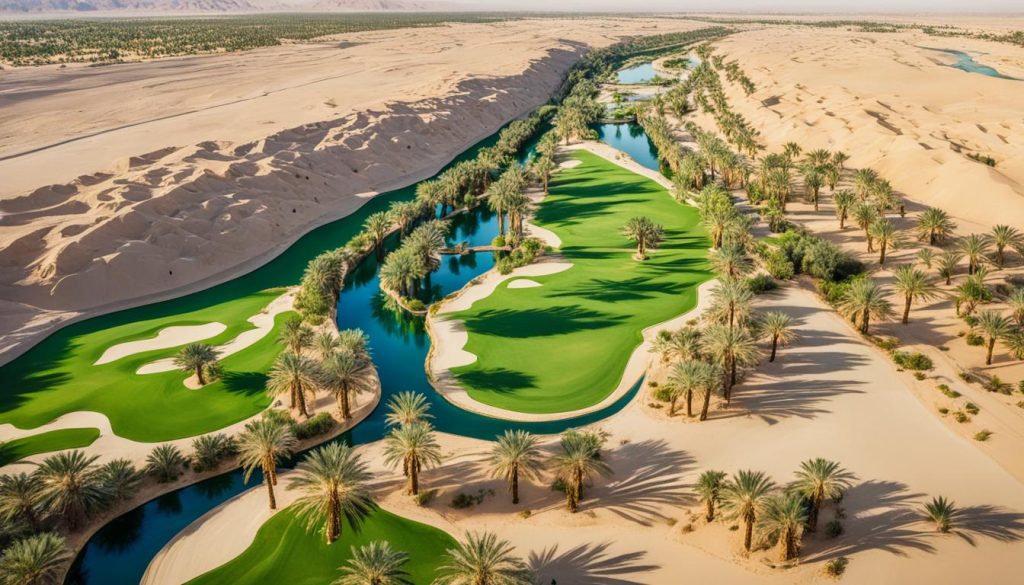
Sharjah: The Cultural Capital of the Arab World
The emirate of Sharjah is called the “Cultural Capital of the Arab World” by UNESCO. This is because of its strong commitment to keep and share the UAE’s rich culture. It got this title in 1998. Since then, it’s known as a key place for sharjah heritage areas and sharjah cultural capital.
But Sharjah means even more. In 2014, it was named the “Capital of Islamic Culture” by the Organisation of Islamic Cooperation. This showed its role in supporting Arabic and Islamic traditions. The honor led Sharjah to do even more to share its deep cultural roots. It did this through many museums, heritage sites, and cultural spots.
One big effort is the “Culture without Borders” project. It aims to give 50 books to each local family in Sharjah. The project has a budget of Dhs 150 million. This big plan shows Sharjah’s dedication to culture. It also shows how it values knowledge and art in its community.
Sharjah’s sharjah heritage areas are proof of its goal to keep the past alive. At the Sharjah Heritage Museum, guests see old pottery and pretty bridal chests. They learn about Arabic embroidery too. This is with gold and silver threads. There are sequins and fine needlework on colorful clothes.
Sharjah also shines through its art. The Emirates Fine Arts Society started in 1980 by His Highness Sheikh Dr. Sultan Bin Mohammad Al Qasimi. It attracts artists from all over the UAE. It gives them a place to grow their art. Plus, the Sharjah Biennial, which began in 1993, is a key event in contemporary art. It’s well-known worldwide.
Sharjah stands out as a leader in cultural excellence in the Arab world. It keeps sharing its culture in many ways. The emirate continues to interest everyone who visits or lives there. It invites them to enjoy the timeless traditions and vibrant art that make it special.
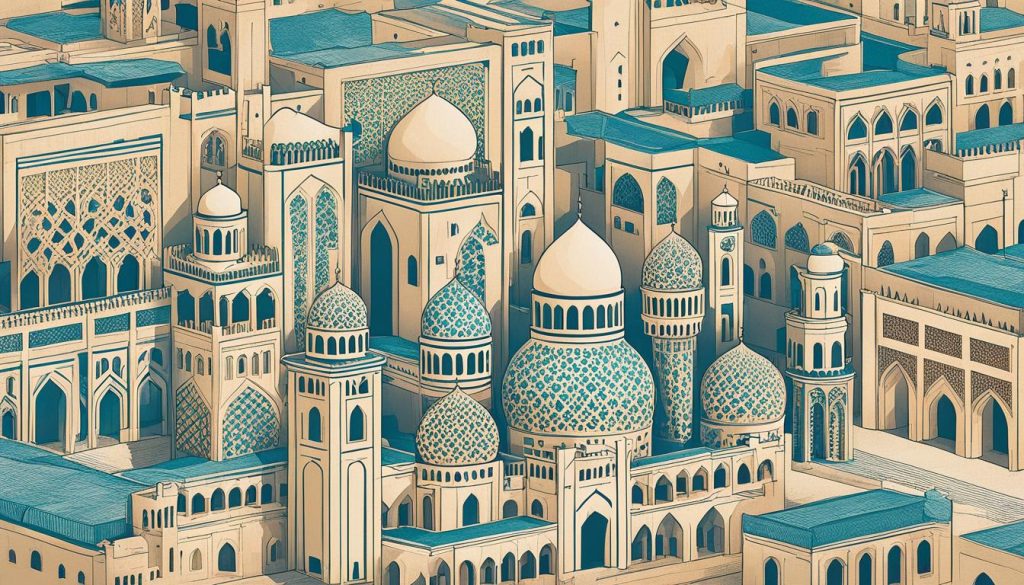
UAE's Efforts in Preserving Cultural Traditions
The United Arab Emirates (UAE) is working hard to keep its culture alive. The government and cultural groups use many ways to do this. They want to make sure the traditions of the UAE are remembered for the future.
Annual Festivals and Events
The UAE has many festivals and events all year. They show the rich culture and history of the country. Events like the Qasr Al Hosn Festival and the Sheikh Zayed Heritage Festival allow everyone to see Emirati customs and crafts. They also let people taste the delicious food and enjoy the music.
These celebrations help everyone learn about, appreciate, and cherish the UAE’s cultural heritage.
Heritage Clubs and Research Centers
The UAE also has groups and centers focused on tradition. The Emirates Heritage Club, started by the UAE’s first leader, helps in keeping traditions alive. It does this by organizing cultural activities and doing research.
There’s also the Juma Al Majid Center. It looks deeply into the UAE’s history, art, and traditions.
The Abu Dhabi Heritage Authority plays a big role too. Set up by President Sheikh Mohamed, it helps keep Emirati culture vibrant. It works on making tradition important today.
All these efforts in the UAE underline a strong promise to keep culture alive and thriving. The country started the Cultural Programmes and Heritage Festivals Committee in 2013. This group works to put on many cultural events across the UAE.
The UAE is proud to celebrate its unique culture. It makes people feel a strong connection to their nation. This feeling of pride and belonging is shared by everyone who lives in the UAE.
| Initiative | Year Established | Purpose |
|---|---|---|
| Abu Dhabi Heritage Authority | Established by President Sheikh Mohamed | Preserve Emirati heritage and traditions |
| Emirates Heritage Club | 1993 | Promote UAE’s heritage |
| Cultural Programmes and Heritage Festivals Committee | 2013 | Organize cultural events |
The UAE’s commitment to saving its traditions stands strong. By working on many levels, the UAE makes sure its culture stays alive and loved. These efforts promise that the UAE’s culture and heritage will shine for many years to come.
UAE Heritage Villages: A Window into the Past
The United Arab Emirates is rich with heritage villages. Here, visitors can see the culture of the old days come to life. These sites are carefully built to look and feel just like they did in ancient times.
At the uae heritage villages, anyone can dive into history. This means seeing, hearing, and feeling what life was like before. You’ll find lively markets, workshops, and peaceful spots. It’s a true trip back in time, letting you absorb the real Emirati cultural practices.
Exploring the UAE's Emirati Heritage Villages
The Fujairah Heritage Village is one great example, opened in 1996. It takes up 6,000 square meters in Madhab and showcases local art and architecture. Step back in time and feel the Emirati culture and its rhythms here.
Then, there’s the Hatta Heritage Village which opened in 2011. It brings to life how people lived daily in the past. With old buildings and huts, it’s like walking in ancient village streets.
- The Shindagha Heritage Village tells the story of a lively coastal region through its opening in 1997, part of the Al Shindagha Historical District.
- Abu Dhabi’s Heritage Village, founded in 2001, spreads over 16,900 square meters, showcasing the UAE’s cultural roots deeply.
- Al Jazeera Al Hamra in Ras Al Khaimah, the home of the Zaab tribe, reflects local architecture and life.
These uae heritage villages keep the past alive. They show how old traditions, skills, and a sense of community have carried on for many years.
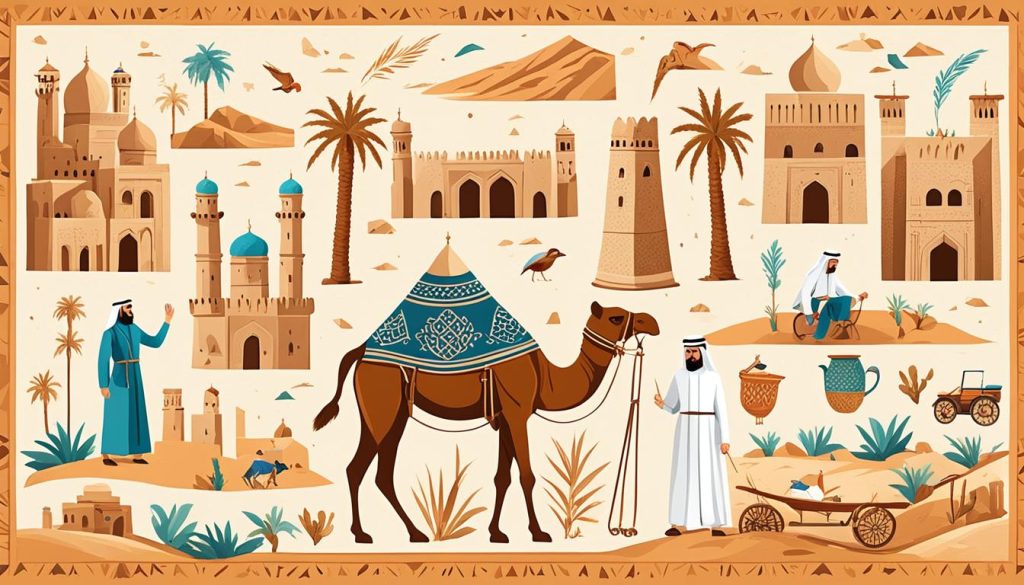
“Visiting the heritage villages in the UAE is like stepping back in time, where you can truly immerse yourself in the authentic culture and traditions of this remarkable country.”
For those who love history or seek to understand different cultures, the emirati heritage villages are a must-visit. They offer an experience you won’t soon forget, rich in beauty and tradition.
UAE Heritage Sites
The United Arab Emirates has a cultural history that goes back thousands of years. In each of the seven emirates, you can find old forts, mosques, and museums. These places tell the story of the UAE’s long and rich past.
Exploring Historic Forts, Mosques, and Museums
The Fujairah Fort stands out as a brilliant piece of Emirati architecture from the 15th century. It sits on a hill, giving great views and showcasing old defense methods.
The Umm Al Quwain Fort is a key site, dating back to the 18th century. It shows the life of its past residents through its halls and towers. Walking through it feels like a trip back in time.
To dive deep into the UAE’s culture, visit the Ajman Museum. This museum is in a restored fort. It is filled with historical artifacts, crafts, and stories of Emirati life.
The Ras Al Khaimah National Museum is another amazing place to explore. It shows ancient tools, pottery, and more. These items tell the story of the region from ancient times to now.
The Hili Archaeological Park in Al Ain lets you see early UAE settlements. It has tombs and structures that are thousands of years old. A visit here is like looking through a window into the UAE’s ancient history.
In Fujairah, the Bidiya Mosque is the oldest mosque in the UAE, from the 15th century. It is known for its detailed design and history linked to Islam. This place is a must-see for those curious about the UAE’s religious roots.
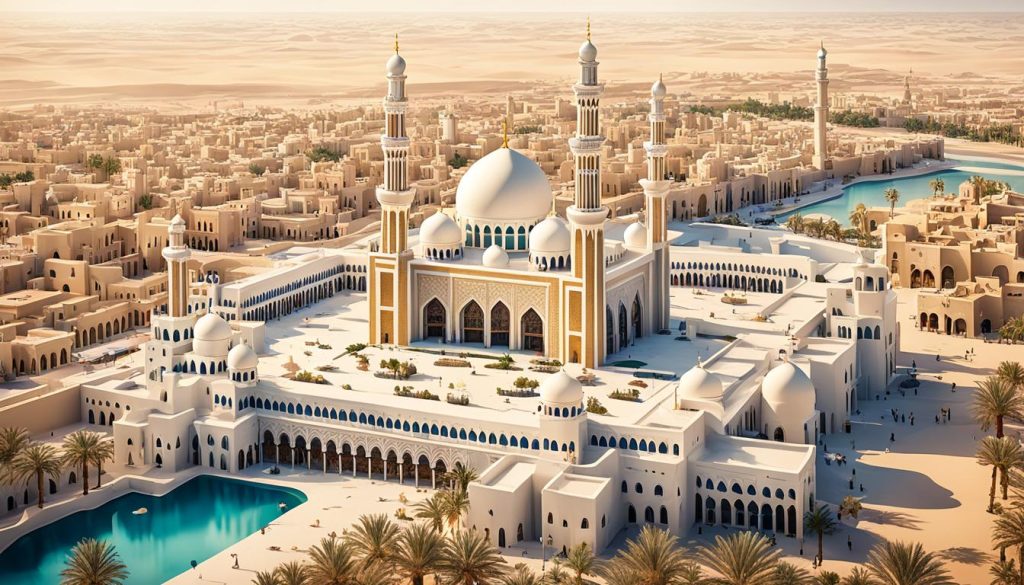
“The UAE’s heritage reflects diversity, identity, hospitality, tolerance, and family cohesion.”
These sites and museums let you explore the UAE’s past. They show how the country has grown from its early days to the vibrant place it is now.
Louvre Abu Dhabi: A Universal Museum
The Louvre Abu Dhabi is a groundbreaking cultural institution. It serves as a hub for global exchange and understanding. As the first universal museum in the Arab world, it showcases a diverse collection. This collection includes artwork, artifacts, and historical items from many civilizations and cultures.
The museum’s innovative architecture and approach aim to foster dialogue between different traditions. This reflects the UAE’s commitment to promoting cultural appreciation.
The Louvre Abu Dhabi’s iconic dome weighs a remarkable 7,500 tonnes. This is the equivalent of the Eiffel Tower in Paris. It is a testament to the museum’s architectural grandeur. The dome features an intricate pattern with 7,850 stars, with the largest star being 13 meters in size and weighing 1.3 tonnes.
Four hidden piers support the dome, creating a captivating floating effect. The dome spans 180 meters in diameter and is 36 meters above the ground.
Established in March 2007, the Louvre Abu Dhabi is a result of a partnership between the UAE and France. It presents cultural achievements from prehistory to the present day. The artworks are arranged in a chronological order, promoting respect, curiosity, learning, and self-reflection.
Artworks entering the collection are carefully chosen. They are selected based on their importance, condition, and their story. This is done following strict international protocols.
The Louvre Abu Dhabi’s acquisition committee is led by HE Mohamad Al Mubarak. Laurence des Cars from the Musée du Louvre is the Vice-Chairman. The museum has 24,000 square meters in total. It includes 8,000 square meters of galleries.
By 2019, over 2 million people had visited the museum. This makes it the most visited museum in the Arab world.
The Louvre Abu Dhabi is part of a large cultural development plan. This plan is for Saadiyat Island in Abu Dhabi. Other cultural projects planned for the island include the Zayed National Museum and the Guggenheim Abu Dhabi.
There will also be a performing arts center, a maritime museum, and arts pavilions. These projects all contribute to the UAE’s vision of becoming a global hub for arts, culture, and education.
“The Louvre Abu Dhabi is a testament to the UAE’s commitment to cultural exchange and understanding. This universal museum showcases the richness and diversity of human civilization, fostering a spirit of openness and dialogue that is crucial in our interconnected world.”
With unique architecture, a diverse collection, and a commitment to cultural diplomacy, the Louvre Abu Dhabi has established itself as a top cultural institution. It attracts visitors from around the world to explore the shared heritage of humanity.
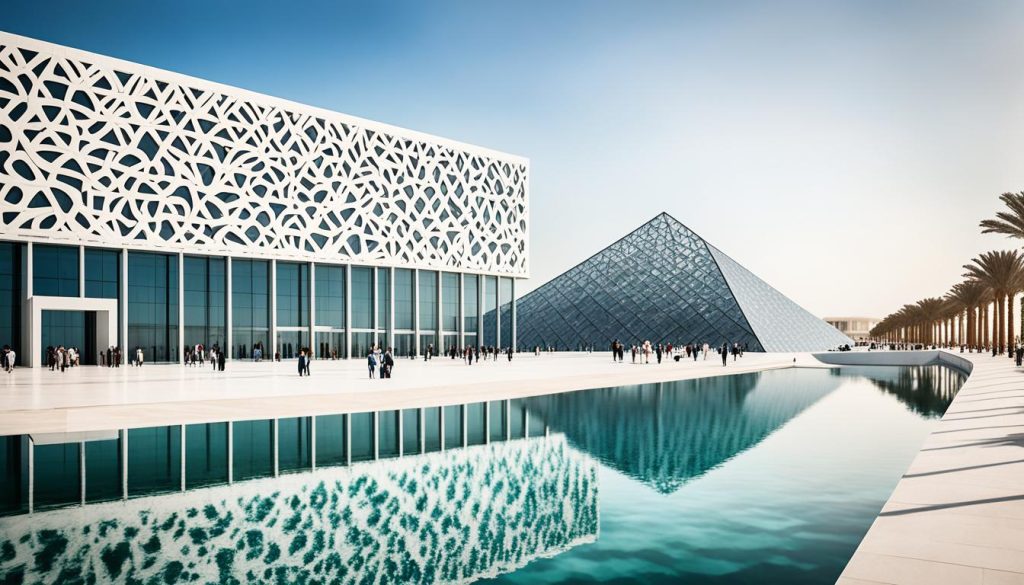
Natural History Museum Abu Dhabi
Get ready for an amazing journey at the Natural History Museum Abu Dhabi. It’s opening by the end of 2025. This top-notch museum will wow you with its rare natural history specimens.
It will show us the Earth’s story from the past to the future. The museum covers over 35,000 square meters and will be the region’s biggest.
This museum was designed to look like natural rock shapes. It was done by Mecanoo, a well-known architecture firm. The design uses pentagon shapes to show cellular and plant structures.
Unveiling Earth's Fascinating Treasures
Get ready to see the world’s natural history through the museum’s amazing collections. You’ll meet “Stan,” a Tyrannosaurus rex who lived 67 million years ago. It’s 11.7 meters long.
Also, discover the Murchison Meteorite, a cosmic piece that holds stardust from 7 billion years ago. Experience displays that help you learn about the universe, Earth’s history, and life’s start. The museum will also do research in science areas.
The museum opens in 2025 and marks a big step in the UAE’s love for nature. As part of the Saadiyat Cultural District, it will be a key place to explore Earth’s wonders.
Guggenheim Abu Dhabi: Modern and Contemporary Art
The Guggenheim Abu Dhabi will be a top museum for modern and contemporary art. It will focus on art from West Asia, North Africa, and South Asia. This museum is designed to help us understand how art has influenced our world.
It is designed by Frank Gehry and will be huge, covering 320,000 square meters. This will make it the biggest Guggenheim museum. Costing around US$200 million, it mixes Arabian tradition with modern looks. It has distinctive cones that look like traditional UAE wind-towers.
The museum will have many artworks from the region and around the world. It aims to show how different cultures influence art. Especially, it will highlight art from West Asia, North Africa, and South Asia since the 1960s.
It’s located in the Saadiyat Cultural District, near other important cultural places like the Louvre Abu Dhabi. These places together are making a big impact on the world of art. They attract people who love art and tourists from all over.
The museum’s opening was delayed, but it’s now set to open in 2022. It’s a big project for the UAE, showing its dedication to the arts. It will bring contemporary art together with tradition in a meaningful way.
“The Guggenheim Abu Dhabi will be a game-changer, not just for the UAE but for the entire region. It will showcase the rich artistic heritage and diverse cultural narratives of West Asia, North Africa, and South Asia, inspiring a new generation of art enthusiasts and creating a global platform for artistic exchange.”
| Key Facts | Figures |
|---|---|
| Estimated Area | 320,000 square meters |
| Estimated Cost | US$200 million |
| Gallery Space | 13,000 square meters |
| Exhibition Space | 18,000 square meters |
| Seating Capacity | 350-seat theatre |
The Guggenheim Abu Dhabi is changing the art scene in the guggenheim abu dhabi and the uae modern art museums area. It’s committed to showcasing art and culture from West Asia, North Africa, and South Asia. This will inspire many people and create a global platform for art.
Zayed National Museum: Honoring Sheikh Zayed
The Zayed National Museum is set to be a top museum in the UAE. It’s all about remembering Sheikh Zayed. He was the UAE’s founding father. This place will show how his ideas and work still matter today.
Opening its doors in 2025, the museum mixes modern design with saving the planet. Back in 2009, a deal with the British Museum promised to bring 500 cool items to the UAE. Though it got delayed, it’s finally coming to life, with major construction companies now leading the way.
Lord Norman Foster designed the museum with towers that look like falcons, a big part of UAE traditions. You’ll be able to go up a man-made hill for a great view. Plus, a beautiful garden will link the museum to the sea and other parts of the area.
Inside, the museum will have galleries full of national treasures and cool stuff from other museums. This makes it a lively spot for culture fans from near and far. You’ll learn about Sheikh Zayed’s life and UAE’s story, from the past to now, in different areas of the museum.
The Zayed National Museum wants to teach everyone, no matter their age or what they know. It aims to help the community learn more, with things that fit with the UAE’s schools. It’s also a place for studying the country’s old times and traditions. It supports digging into the UAE’s roots with a million dirhams every year.
This museum is a big thank-you to Sheikh Zayed. It’s a place to celebrate Emirati people and their rich history. The Zayed National Museum keeps Sheikh Zayed’s memory alive for the future.
UAE Mosques: Architectural Marvels
The United Arab Emirates (UAE) has many historic mosques showing its Islamic roots. The Sheikh Zayed Grand Mosque in Abu Dhabi and Jumeirah Mosque in Dubai are stunning examples. They allow people to see the beauty and meaning of Islamic architecture.
Sheikh Zayed Grand Mosque: A Breathtaking Masterpiece
In Abu Dhabi, you can find the Sheikh Zayed Grand Mosque. It mixes Mamluk, Ottoman, and Fatimid styles. This great building is where the UAE’s founder, Sheikh Zayed, rests. Its size, detail, and tall minarets make it an amazing sight.
Jumeirah Mosque: A Tribute to Fatimid Tradition
Dubai’s Jumeirah Mosque highlights the UAE’s Islamic history. It’s made using white stone in the Fatimid style. With its twin minarets and central dome, it’s a beautiful part of Dubai’s skyline. This mosque is open to everyone, giving a chance to see its detailed interior and learn about Islamic architecture.
“These mosques are not just places of worship, but also masterpieces that showcase the cultural and architectural richness of the UAE.”
The sheikh zayed grand mosque and jumeirah mosque are incredible in the UAE. They show the deep Islamic heritage and preservation of cultural traditions. These structures are key examples of the country’s rich history and architectural beauty.
UAE Heritage Sites
The United Arab Emirates (UAE) is a treasure trove of heritage. It includes ancient oases, archaeological wonders, historic forts, and more. These uae historical sites show the deep cultural roots of the nation. They allow visitors to experience real Emirati history firsthand. By visiting these uae cultural heritage sites, travelers learn about the UAE’s traditions and the spirit of its people.
The Al Ain Oasis is a standout site. It is the region’s largest oasis, covering 1,200 hectares. The oasis reflects the UAE’s rich agricultural history and the use of falaj, an ancient irrigation system. This system has supported life in the area for centuries.
The Hili Archaeological Park in Abu Dhabi is another must-see spot. Dating back to 2500 BCE to 2000 BCE, it features monuments from the Umm an-Nar era. It offers insights into the early societies that once flourished there.
- The Jebel Hafeet Tombs mark the start of the Bronze Age. They are known for their unique beehive shape.
- Bida Bint Saud features stone tombs that are 5,000 years old. It showcases the region’s ancient importance.
- Umm an-Nar Island is a significant site with much still to uncover. The excavations so far have revealed homes made of marine rocks and a cemetery.
Aside from ancient wonders, the UAE also boasts many historic forts, mosques, and museums. The Al Bidyah Mosque in Fujairah is the UAE’s oldest. The Ed-Dur Site in Umm Al Quwain offers insights into various historical periods. These landmarks tell the story of the UAE’s rich cultural heritage.
| Heritage Site | Location | Historical Significance |
|---|---|---|
| Khor Dubai | Dubai | A natural seawater inlet important for Dubai’s growth as a trading port. Its history goes back to 1587. |
| Dhayah | Ras Al Khaimah | A unique cultural landscape featuring traditional settlements. It shows how people interacted with the environment, including the use of palm gardens and mangroves. |
| Jazirat Al Hamra | Ras Al Khaimah | An old pearl trading town that offers a look into the country’s past reliance on the pearling industry. |
| Julfar | Ras Al Khaimah | An ancient commercial hub that had trade connections throughout the Gulf, Indian Ocean, East Africa, and Southeast Asia. It highlights the area’s historical importance in trading. |
| Shimal | Ras Al Khaimah | It is an archaeological site near the Ru’us-al-Jabal mountains with evidence of ancient settlements. It gives clues about the region’s early history. |
The uae historical sites and uae cultural heritage sites show the UAE’s deep history. Visiting these amazing places allows you to better understand the country’s cultural traditions. They highlight the enduring spirit and traditions that define the UAE.
Exploring Traditional Emirati Culture
The United Arab Emirates has a rich culture from its history and traditions like Islamic, Arab, and Persian. You see this in what they wear, their food, and how they behave, which have passed down for generations.
Emirati Traditional Clothing
The traditional clothes in the UAE are the kandura for men and the abaya for women. They keep people cool in the hot weather and show their cultural and religious beliefs. This shows how traditions mix with daily life there.
Emirati Traditional Cuisine
Emirati food is a mix of tastes from the desert, sea, and farms. It uses local ingredients like dates and camel milk, spiced with saffron and cinnamon. This creates meals that stand out and are very tasty.
Emirati Social Customs
The UAE’s social ways highlight its cultural richness. For example, how they greet each other and the special role of the majlis. This all shows their strong sense of hospitality and community.
Exploring Emirati clothes, food, and social traditions helps visitors understand and respect the country’s culture much more.
“The UAE’s cultural heritage is a tapestry of ancient traditions and modern influences, woven together to create a unique and captivating identity.”
Literature and Poetry: Emirati Voices
The UAE has a rich literary world. Emirati writers and poets have added a lot to the country’s culture. Emirati poetry is especially notable for its long history. It covers many themes like satire, patriotism, religion, and love.
Emirati literature includes both plays and stories. Emirati authors have worked hard to share the UAE’s unique experiences through their writings. The literary scene in the UAE started growing in the 20th century. Now, it’s full of talented writers.
Emirati Poets and Writers
Emirati poets and writers have made a big impact. Some famous names include:
- Maha Gargash, a Dubai native, has worked in communication and media for over two decades. She’s also created radio programs.
- Omar Saif Ghobash has served as UAE Ambassador to Russia. He’s also an Assistant Minister for Cultural Affairs. He supports works involving Arabic translations.
- Salha Obeid has written three short story collections and later ventured into novels.
- Shamma Al Bastaki won the 2019 Admaf Creativity Award for her poetry collection, “House to House.”
- Reem al-Kamali edits the cultural section of Al-Bayan. She joined a writers’ workshop for talented young writers in 2015.
- Reem Al Kamali wrote the novel “Statue of Dalma” in 2015. It combines fantasy, fiction, symbolism, and mythology.
These writers and poets have shaped the UAE’s literary scene. They’ve helped make the country’s culture rich and shared Emirati perspectives.
Autobiographies and Oral Histories
Besides literature and poetry, the UAE sees interest in autobiographies and oral histories. A few Emiratis have published their life stories. Notable ones include “My Vision” by Sheikh Mohammed bin Rashid Al Maktoum. These books give deep insights into the lives of important Emiratis.
The National Archives of the UAE encourages Emiratis to tell their stories. This project captures personal experiences for future generations. It’s essential for understanding the country’s past and culture.
Promoting Emirati Literature
The Emirates Airline Festival of Literature has been going for 14 years. It helps the world discover Emirati authors and poets. Such events raise the status of Emirati literature and provide a platform for Emirati voices.
As the UAE progresses, its literary scene will grow too. Emirati writers and poets are key in showcasing and preserving the nation’s rich culture.
Conclusion
The United Arab Emirates’ cultural heritage is rich and varied. It combines ancient traditions with modern art. From the Al Ain Oasis to Abu Dhabi’s museums, the UAE is full of cultural wonders.
This country works hard to preserve its past and welcome the future. It protects its treasures, like fixing the Iraq marshlands. These efforts show how much the UAE values its history while aiming towards progress.
The UAE is a fascinating mix of old and new. It shows the importance of keeping traditions alive. Exploring UAE’s heritage lets visitors learn about the Emirati people’s strength and creativity.
FAQ
What are some of the key aspects of Emirati culture?
Emirati culture is known for being welcoming and open. It values unity in families and loves the country’s roots. This includes traditions tied to the land.
How has Islam influenced the UAE’s cultural heritage?
Islam shapes much of the UAE’s life, from its architecture to its food. It brings together local ways and the wider Muslim world.
What is the significance of the Al Ain Oasis and the archaeological sites in the UAE?
The Al Ain Oasis and its ancient sites in Abu Dhabi reflect deep history. Recognized by UNESCO, they show early life in the UAE.
What is Sharjah’s designation as the “Cultural Capital of the Arab World”?
Sharjah is at the heart of Arab cultural achievement. Named by UNESCO, it highlights the region’s diverse heritage.
How does the UAE government and cultural authorities work to preserve the country’s cultural heritage?
Every year, the UAE celebrates its traditions through festivals and other events. These events, along with research centers and clubs, aim to keep the culture alive.
What are the UAE’s heritage villages, and what do they offer to visitors?
Heritage villages across the UAE bring the past to life. Visitors can see how Emiratis once lived, in places like traditional houses and markets.
What historic sites can visitors explore in the UAE?
Explorers can find old forts and archaeological sites throughout the UAE. Museums and mosques, like the historic Bidiya Mosque, also welcome visitors to learn about the country’s history.
What is the significance of the Louvre Abu Dhabi?
The Louvre Abu Dhabi connects cultures through its art and history. It breaks new ground as a place for shared understanding, featuring diverse collections.
What can visitors expect from the upcoming Natural History Museum Abu Dhabi?
Opening in 2025, the Natural History Museum will amaze with rare specimens and interactive exhibits. It will inspire visitors to think about the planet’s story.
What is the significance of the Guggenheim Abu Dhabi?
The Guggenheim Abu Dhabi will focus on modern and contemporary art from around the world. It’s a place for global stories to be told through art.
What is the purpose of the Zayed National Museum?
This museum will honor Sheikh Zayed and the UAE’s history. It will tell the story of the UAE and its people, showcasing Sheikh Zayed’s contributions.
Can you describe the architectural significance of the UAE’s mosques?
The UAE’s mosques are stunning, blending traditional and modern styles. Iconic places like the Sheikh Zayed Grand Mosque show the beauty of Islamic architecture.
What are some key aspects of traditional Emirati culture?
Traditional culture in the UAE is rich with Islamic and Arab traditions. This is seen in its unique clothing, delicious food, and social customs like Emirati coffee.
How is Emirati literature and poetry contributing to the country’s cultural legacy?
Emirati poetry goes back many years. It has evolved and speaks to various themes. Today, Emiratis are also making their mark in drama and fiction, widening the country’s literary scene.
